by Winding Pathways | Dec 24, 2020 | (Sub)Urban Homesteading, Chickens, Garden/Yard
Late December is special. There are lots to be thankful for and a good reason to celebrate. The solstice just passed, promising a daily addition of sunlight and signaling that spring is on the way. Then there’s a multitude of seasonal, cultural holidays and Holy Days. St. Lucia’s Day, Las Posadas, Yule Winter Solstice, Boxing Day, Kwanzaa, Christmas, and New Year’s Day.
People everywhere enjoy special year-end treats. For us, it’s stollen and pickled herring plus delicious cookies and, in some years, a tender roast beef dinner.
We remember our chickens and give them special year-end treats. They need it. Few things are as delicious to a hen as a juicy grasshopper or fresh grass shoot. By now those are just memories, and the poor birds have to make do with a diet of nutritious, but boring, commercial mash.
Jazz Up the Diet and Relieve Boredom
So, while keeping plenty of quality mash in the feeder, we jazz up their diet with these things:
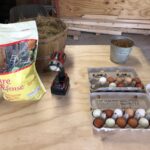
We vary the treats.
Mealworms: Our chickens might not like them as much as a June caterpillar but dried mealworms are a great winter substitute, so we sprinkle a couple of handfuls in the coop every day. These treats can be bought online or in farm and pet stores.
Sunflower seeds: Many people put sunflower seeds out for cardinals, chickadees, and other birds to enjoy on frosty days. Chickens also love them. We toss a handful of black oil sunflower seeds with the hulls on into the coop. They quickly disappear.
Squash seeds: We enjoy eating butternut and other winter squash during the cold days. Our chickens devour the seeds.
Scratch: Chickens love eating commercial scratch grain, a blend of corn, milo, wheat, and oats. A handful or two a day is plenty. It’s chicken candy but low in protein. Be careful when buying scratch. Some brands include a high percentage of milo, a grain that chickens don’t favor. It’s a round reddish colored seed. Try buying scratch with a low milo content.
Flock block: Each winter we buy a flock block. They’re made by several companies and are compressed scratch grain fortified with molasses and other treats. We simply put the heavy block on the coop floor. It takes the birds several weeks to eat it all and keeps them busy picking out tidbits. Farm and pet stores sell them. Some folks make their own!
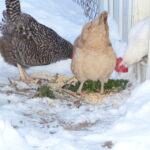
We toss a few treats outside the pophole door to entire the hens outside in winter.
On winter days, before enjoying our morning coffee and breakfast we open our coop’s pop hole door and scatter some chicken treats. We’re sure to say good morning and thanks to our hard-working hens.
-
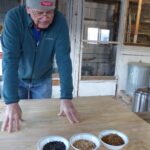
-
Rich shows three treats while a hen in the coop checks out what is happening.
-

-
Hens check out new foods carefully.
-
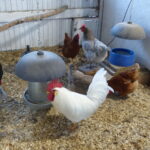
-
Chickens gather ’round the Flock Block.
-
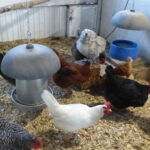
-
Satisfied that the Flock Block is something good, the hens and rooster begin to peck at it.
by Winding Pathways | Sep 10, 2020 | (Sub)Urban Homesteading, Chickens, Garden/Yard
Clouds darkened in the late morning of August 10, 2020, as a thunderstorm warning was broadcast by radio stations. That’s common during Iowa summers, so we weren’t overly concerned. A half-hour later, a roaring wind engulfed Cedar Rapids. It was a derecho bearing winds up to 140 miles an hour.
We watched our young trees bend before the tempest. Then came the terrible part.
First, our black oaks tumbled down. Then, the black cherries and hackberries tumbled down before the wind. Our massive black walnut stood until a ferocious blast tore its branches and leaves off.
The derecho lasted longer than most – over 40 minutes – and left as quickly as it had arrived. The damage was mindboggling. We soon learned that Cedar Rapids lost 65% of its trees. A quick count showed that 47 of our 53 mature trees were either on the ground or stripped of leaves and branches. We lost privacy and shade and gained a view.
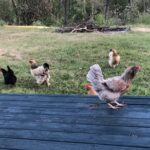
For several days the chickens were truly “free-ranging.”
We worried about our 20 chickens. The storm came so quickly that we couldn’t lure them into the coop. The wind destroyed the chicken run’s fence. The birds were fine and, with the fence down, began their first neighborhood tour. Even before the rain stopped!
We couldn’t erect a temporary fence for several days, so the chickens were truly free-ranging. They roamed around, and we often didn’t even know where they were.
But, every once in a while, a hen returned to the coop to lay her egg in the nest.
Each sundown all the chicks came home for the night. All 20!
With power off and vast damage over a large area, we were fearful about food. Our freezer warmed and the wind damaged many of our garden crops. Would grocery stores reopen????. Could we even get through on the tree chocked roads??? We didn’t know. But it was soon obvious that our hens were nonplussed by the storm and kept giving us fresh eggs.
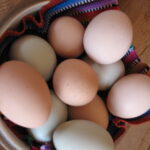
The chickens kept on laying eggs.
Assuming a chicken flock survives an immediate disaster – flood, fire, or storm – they’ll continue laying nutritious eggs when other food may not be available. They are valuable disaster companions.
by Marion Patterson | Sep 4, 2020 | Chickens
Well, you don’t. These powerful storms develop quickly from what seems like a “normal” thunderstorm. Even the weather service can be caught off guard as happened Monday, August 10, 2020, as a series of storms developed over Nebraska and swept East rapidly.
Gustavus Hinrichs, a Danish immigrant, and professor at the University of Iowa, recognized these storms differ from hurricanes because the winds move quickly in a straight line. Hence, derecho.
This link has satellite imagery of the formation of the derecho with Eastern Iowa being the epicenter. Over 20 counties have qualified for disaster aid.
Winding Pathways sustained damage especially the trees. And, we are working each day in the community to help recover. In the future, create.
For now, we invite readers to support local organizations in communities damaged by natural forces like fires, storms, and droughts.
 We are OK. The chickens were truly “free-ranging” for ten days before we got temporary fencing back up. They keep eating our food scraps, foraging for insects, and laying eggs so all is well.
We are OK. The chickens were truly “free-ranging” for ten days before we got temporary fencing back up. They keep eating our food scraps, foraging for insects, and laying eggs so all is well.
And, we will update as we can.
Go to our posts on preparedness and we will post updates of what we learned to add to preparedness. Remembering that different emergencies require different responses and different preparedness techniques.
Be well.
by Winding Pathways | Mar 5, 2020 | (Sub)Urban Homesteading, Chickens
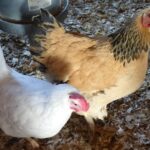
Even healthy-looking chickens can die suddenly.
Our chickens aren’t really pets. We don’t give them names and every once in a while, we sell or give away a few. Even so, we get attached to our hens as we recognize their individual personalities and enjoy their antics.
Maybe it’s silly but we feel sad when one dies. That happened recently when we went into our coop to find one of our Buff Brahmas moping. She was huddled in a corner crouched down into the sawdust litter. The next morning, she was dead.
We carefully examined her and learned she was well fleshed and had no obvious signs of either disease or injury. We’ll never know what caused her untimely death but over the years we’ve developed a procedure we use when a chicken dies. Here’s what we do:
- Carefully remove the dead bird and dispose of its body. We usually either bury it or gently carry it down in the woods and let nature recycle it. Often a raccoon makes a meal of her the first night. Most municipal waste disposal companies will allow putting an animal carcass in the trash if it’s bagged in three layers of plastic.
- Watch the flock for any sign of disease. If more than one bird dies in a short time, we suspect a disease. We would quickly change out litter, sanitize feeders and waterers and consider taking a bird to the vet. But actually, we can’t remember ever having a disease take a second bird.
We’re careful to protect our flock from disease and practice bio sanitation. Isolation is the best way to keep disease at bay, so we rarely introduce an outside bird to the flock. Because we don’t want to introduce disease, we change clothes and wash up after visiting another flock and before going to our chickens.
Remember to always wash carefully after handling chickens, eggs, feed, or even visiting the coop.
Given nutritious food, protection from dampness and drafts, and practicing biosecurity makes it likely that a backyard flock will stay disease-free, but occasionally a chicken dies. Yup, it’s always sad and it’s part of keeping a flock.
by Winding Pathways | Dec 12, 2019 | Birds, Chickens, Nature
As autumn progresses in the upper Midwest, birds appear and disappear, group and spread out. Pileated woodpeckers have returned to the suet feeders. Chickens help grind up the garden residue and eat the bugs. White-throated sparrows sing a different tune on their way south. Juncos suddenly appear. Bluebirds sit on branches surveying the yards. Hawks send everyone scurrying. Vultures wing one more time overhead before catching the north winds and head to warmer climes.
Watch these robins enjoying a sunny day bath.
-
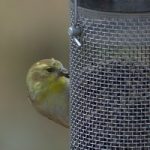
-
Songbirds appreciate high quality seed to sustain them in winter.
-
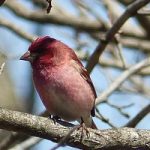
-
Some birds homestead at Winding Pathways.
-
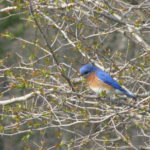
-
Bluebirds hang out on branches.
-
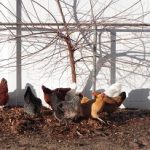
-
Chickens grind up garden residue.
-
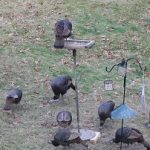
-
Turkeys and squirrels would make short work of seed, leaving none for the small birds.
-
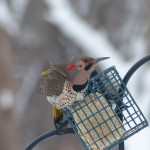
-
Winter is tough on birds so keep your feeders full.
-

-
Fledgling eagle resting in the back yard.
-
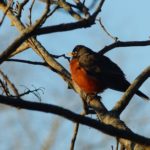
-
A robin surveys the area
by Winding Pathways | Nov 14, 2019 | (Sub)Urban Homesteading, Chickens
Mealworms in the Snow Mama and Chicks in the Snow
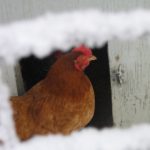
Hens are not dumb clucks!
We were surprised to look out the window on Veteran’s Day morning to see nearly six inches of snow outside. The predicted snow skiff turned into a dump, and we soon fired up the snowblower and put the shovels to use. This much snow in early November is unusual.
Just before we started shoveling, our chickens demonstrated their amazing ability to learn and remember. Every morning we open the pop hole door, and the hens zoom outside with enthusiasm to discover tasty bugs and weed seeds to eat. When we opened the door after the snow, our older hens peered out the door, turned around, and decided the cracked corn we scattered inside the coop was a fine breakfast. They’d remembered snow from last year and knew walking in it yielded cold toes and legs.
Most of our hens are newbies, hatched in mid-July. They’d never seen snow, and when we opened the pop hole door they roared outside, stood perplexed, walked around for a few minutes, and then came right back inside. And, the rooster sang his call from inside. No doubt their toes were cold.
Chickens are often considered witless animals lacking even a shred of intelligence. We know otherwise. Remembering snow proved that our old hens had learned what it was last winter and remembered their cold toe experience over the eight long months since the last frozen white stuff melted. Chickens are no dumb clucks.


















